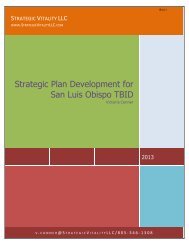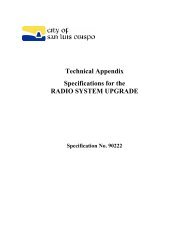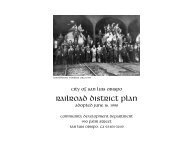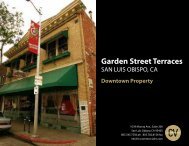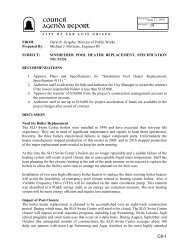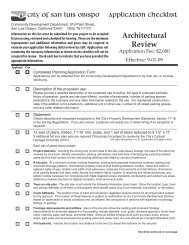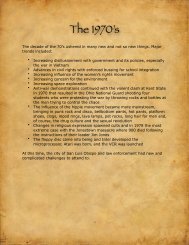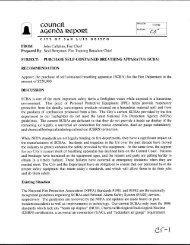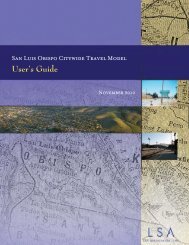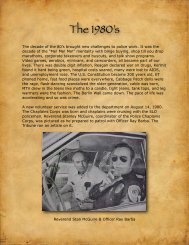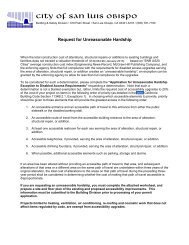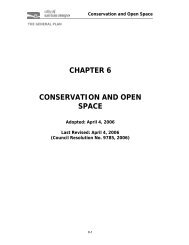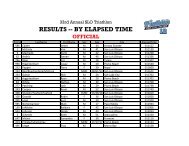Drainage Design Manual - the City of San Luis Obispo
Drainage Design Manual - the City of San Luis Obispo
Drainage Design Manual - the City of San Luis Obispo
You also want an ePaper? Increase the reach of your titles
YUMPU automatically turns print PDFs into web optimized ePapers that Google loves.
Berm. A levee, shelf, or bench along astreambank that may extend laterally in <strong>the</strong>channel to partially obstruct flow, or parallelto <strong>the</strong> flow to contain <strong>the</strong> flow within itsstreambank. May be natural or constructed.Best Management Practice. A practiceused to reduce impacts from a particularland use.Biotechnical approach. An applied sciencethat combines structural, biological andecological concepts to construct livingstructures for erosion, sediment and floodcontrol.Blanket. Material placed on a streambank tocover eroding soil.Boulder. Sediment particle having adiameter greater than 256 mm (10 inches).Bridge. A structure for carrying traffic over awatercourse, depression, or o<strong>the</strong>r obstacle.Brush layer. Live branch cuttingscrisscrossed on trenches betweensuccessive benches <strong>of</strong> soil.Brush mattress. A mattress-like coveringthat is placed on top <strong>of</strong> <strong>the</strong> soil. Thecovering material is living wood plantcuttings that are capable <strong>of</strong> rooting.Buffer. A vegetated area <strong>of</strong> grass, shrubs ortrees to capture and filter run<strong>of</strong>f fromsurrounding land uses.CalTrans. California Department <strong>of</strong>Transportation.Canopy. Overhead branches and leaves <strong>of</strong>riparian vegetation.Canopy cover. Vegetation projecting over astream, including crown cover (generallymore than 3 feet above <strong>the</strong> water surface)and overhand (less than 3 feet above <strong>the</strong>water surface).Capacity. The effective carrying ability <strong>of</strong> adrainage structure or facility. May also referto storage capacity.Carry Over. The quantity <strong>of</strong> water whichcontinues past an inlet.Catch Basin. A basin combined with astorm drain inlet to trap solids.Catchment Area. (1) The contributing areato a single drainage basin, expressed inacres, square miles, or o<strong>the</strong>r unit <strong>of</strong> area.Also called <strong>Drainage</strong> Area or Watershed. (2)The area served by a drainage systemreceiving storm and surface water; or by awater-course.Caving: The collapse <strong>of</strong> a streambank byundercutting due to wearing away <strong>of</strong> <strong>the</strong> oteor an erodible soil layer above <strong>the</strong> toe.Cellular Confinement. A design elementthat consists <strong>of</strong> a honeycomb-like structuralmaterial, placed to allow access across wetareas to distribute load and minimizeenvironmental damage, such as ruts.Channel. A natural or man-made waterwaythat continuously or periodically passeswater.Channel roughness. The irregularity <strong>of</strong>streambed materials sizes and channel formin plan and cross-section that causesresistance to flow.Channel scour and fill. Erosion andsedimentation that occurs during relativelyshort periods <strong>of</strong> time; degradation andaggradation apply to similar processes thatoccur over a longer period <strong>of</strong> time.Channel stability. A relative measure <strong>of</strong> <strong>the</strong>resistance <strong>of</strong> a stream or river to erosion.Stable reaches do not change markedly inappearance from year to year.Channel Storage. The volume <strong>of</strong> waterstored in a channel. Generally considered in<strong>the</strong> attenuation <strong>of</strong> <strong>the</strong> peak <strong>of</strong> a floodhydrograph moving downstream.Check. A barrier placed in a ditch, canal orchannel to decrease <strong>the</strong> velocity <strong>of</strong> <strong>the</strong> flow<strong>of</strong> water so as to minimize erosion <strong>of</strong> <strong>the</strong>bottom and banks or to raise <strong>the</strong> level <strong>of</strong> <strong>the</strong>water. Also used for diverting water fromone channel to ano<strong>the</strong>r, as in irrigationusage.Check dam. A structure placed bank tobank downstream from a headcut.Clay. Cohesive soil whose individualparticles are not visible to <strong>the</strong> unaidedhuman eye. Soil can be molded into a ballthat will not crumble.Cobble. Sediment particles larger thanpebbles and smaller than boulders. Usually64 - 256 mm (3 to 8 inches) in diameter.Cohesive soil. Microscopic soil particlesthat have natural resistance to being pulledapart at <strong>the</strong>ir point <strong>of</strong> contact.Coir. A woven mat consisting <strong>of</strong> coconutfibers. Generally used for various soilerosion control practices such as surfaceslope protection and <strong>the</strong> construction <strong>of</strong>geogrids.Concentrated Flow. Flow which is alteredfrom its natural surface run<strong>of</strong>f and hasaccumulated into a single narrow ditch,channel or pipe.Conduit. Any pipe, arch or box throughwhich water is conveyed.



